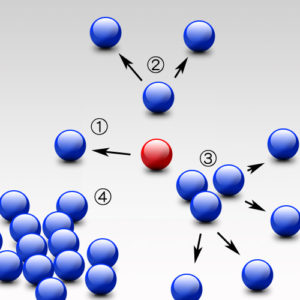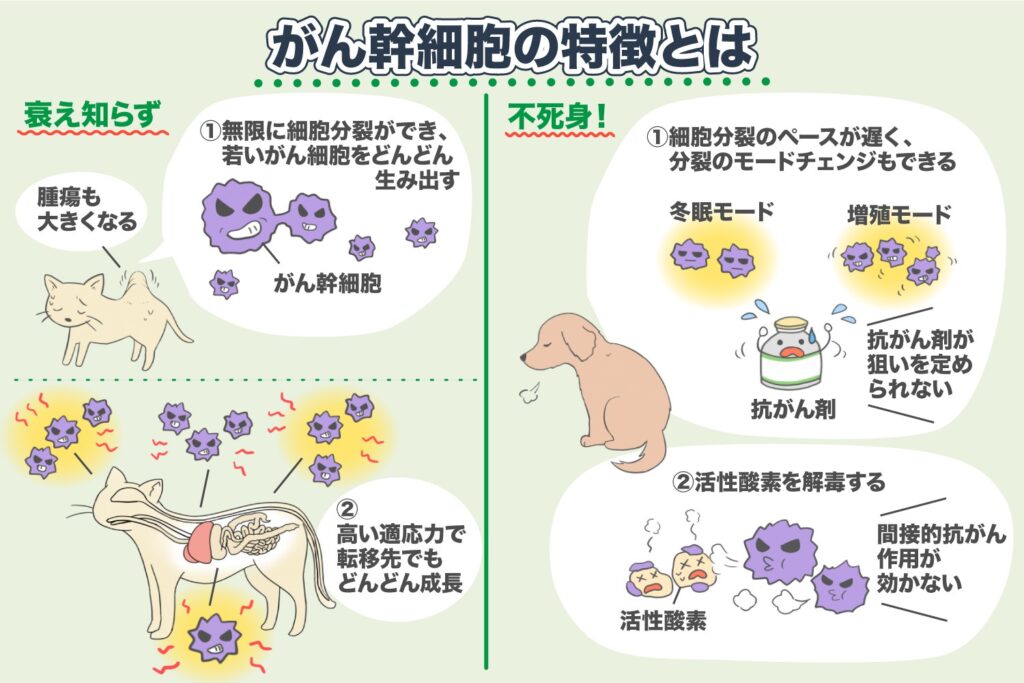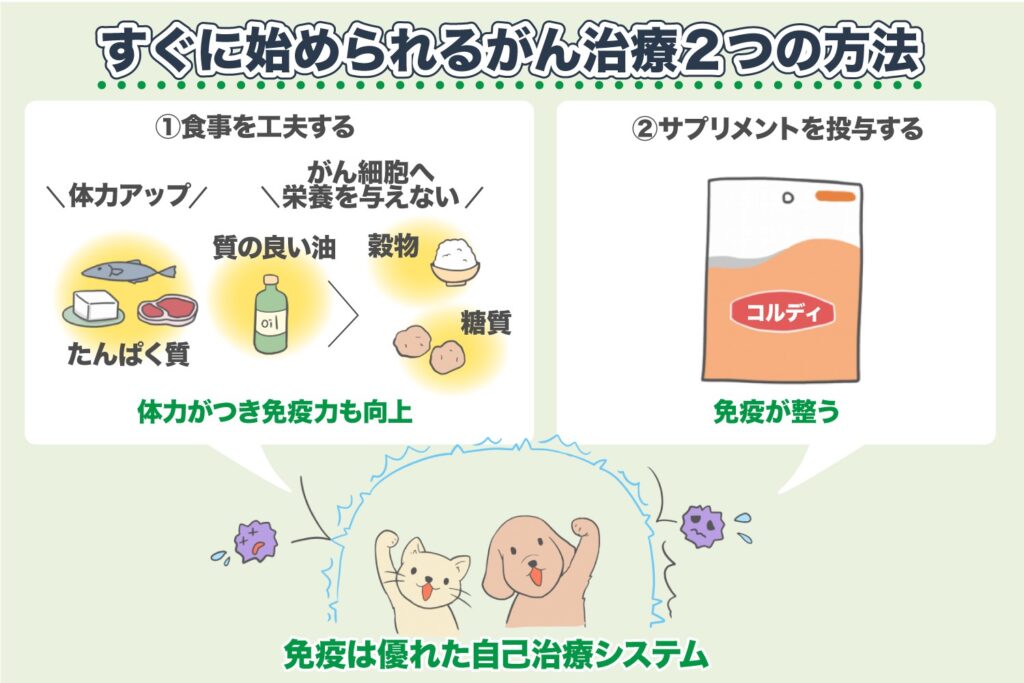Cancer stem cells are the ringleaders of cancer in dogs, cats, and other pets. In this article, we will explain the characteristics of cancer stem cells and methods to effectively address their power. While it is difficult to attack cancer stem cells with chemotherapy and other treatments, consider implementing immune defenses to prevent cancer stem cells from endlessly producing cancer.
- If malignant tumors (cancer lumps) are left untreated, they will continue to grow due to the characteristics of cancer stem cells.
- Cancer stem cells show high resistance to chemotherapy and radiation therapy.
- It is safe and easy to start with dietary modifications and the administration of supplements to suppress cancer stem cells.
Why can’t we defeat cancer? Why does it recur even after treatment? Recently, there has been an important discovery that unravels this mystery—the discovery of cancer stem cells.
Cancer stem cells cannot be defeated by conventional cancer treatments. They tenaciously survive throughout the animal’s body and promote cancer growth.
目次
- 1 Overview of Cancer Stem Cells
- 2 Characteristics of Cancer Stem Cells
- 3 The Reasons for Recurrence After Surgery
- 4 Why Chemotherapy Isn’t Effective
- 5 Why Radiation Therapy is Ineffective
- 6 Drugs Effective Against Cancer Stem Cells
- 7 Suggestions to Implement Immediately
- 8 Immune Modulating Functions Expected from Cordy
Overview of Cancer Stem Cells
Cancer stem cells are special cells that exist in small numbers within a cancerous mass.
Cancer stem cells have the ability to produce cancer cells indefinitely, serving as the source of cancer cells—the primary cells behind cancer proliferation. They can migrate throughout the body and are deeply involved in the mechanisms of recurrence and metastasis. The true culprit behind cancer growth can be said to be “cancer stem cells.”
Additionally, unlike general cancer cells, they possess several mechanisms that neutralize cancer treatments.
Many studies have been initiated worldwide to target these cancer stem cells. Practical treatment methods are anticipated to emerge, but it may still take some time.
Below is an illustration of cancer cells. The red spheres represent cancer stem cells, while the blue spheres represent general cancer cells.
Here’s your translated text:
—

If we consider cancer as a hierarchical society, the cancer stem cells are the ones reigning at the top. Imagine them as the queen ants continuously producing worker ants.
Cancer stem cells produce cancer cells infinitely and show no signs of weakening. They withstand various cancer treatments and demonstrate particularly high resistance to anti-cancer drugs.
The image below illustrates the situation after administering anti-cancer drugs. Only the common cancer cells are destroyed, while the cancer stem cells remain intact.

Future cancer treatments will need to focus on either eliminating or pacifying cancer stem cells.
So far, no effective treatment methods have been established. Since the existence of cancer stem cells was only recently proven, this is somewhat unavoidable. Even the latest anti-cancer drugs and molecular targeted therapies show little effectiveness against cancer stem cells.
It should be noted that these studies target humans. Research on dogs and cats is virtually nonexistent.
The most practical approach is to utilize the immune strength of pets. In the latter part of this page, we will introduce two simple methods to improve immune function. We hope you find them useful.
Characteristics of Cancer Stem Cells

Characteristics: Two Reasons Why Cancer Grows Almost Perpetually
Cancer stem cells have several key characteristics. The first two points to understand are:
- They can divide infinitely, continuously supplying young cancer cells, thus allowing the tumor to grow.
- They have high environmental adaptability, enabling them to survive in metastatic sites and resume cell division to form new tumors.
If a malignant tumor (cancer mass) is left untreated, it continues to grow larger. This is because cancer stem cells continuously produce highly proliferative young cancer cells.
The produced cancer cells multiply rapidly. While it is believed that the division pace of regular cancer cells eventually slows down, cancer stem cells keep supplying young cells, causing the tumor to continue growing.
Cancer stem cells also possess high environmental adaptability, which is one reason why cancer can metastasize easily. Let’s use a typical example of a metastasizing cancer, mammary gland tumors.
Cancer stem cells accustomed to the mammary environment can survive in the lymph or blood after detaching from the mammary gland. Once they reach the lymph nodes, they adapt to the new environment and start proliferating again. Furthermore, they adjust to the environment of the lungs, create new cancer cells, and form tumors, leading to lung metastasis.
Due to these characteristics, cancer never stops growing and can suddenly metastasize to distant organs (lungs, liver, brain, etc.).
Characteristics: Two Reasons for Their Immortality
Cancer stem cells exhibit high resistance to chemotherapy and radiation therapy due to the following two features:
- They have a slow cell division pace and can switch between dormancy and proliferation modes. Therefore, anti-cancer drugs that target cell division are mostly ineffective.
- They can detoxify reactive oxygen species. Thus, anti-cancer drugs and radiation therapies that use reactive oxygen species as an attack mechanism are mostly ineffective.
Cancer stem cells are initially considered immortal, and they are often referred to as invincible because of their characteristics.
Standard cancer cells are typically destroyed by chemotherapy. Most chemotherapy drugs target cancer cells during their division process. Since standard cancer cells divide rapidly and have many vulnerabilities, they become prime targets.
In contrast, cancer stem cells do not divide as quickly. They can remain dormant, similar to hibernation, and not proliferate at all, making it rare for chemotherapy drugs to target them during this period.
Radiation therapy is also less effective against them. One of the mechanisms of radiation therapy is its indirect anti-cancer effect through reactive oxygen species. However, cancer stem cells can detoxify reactive oxygen species, rendering the treatment ineffective.
The Reasons for Recurrence After Surgery
Recurrence after surgery involves two characteristics: the unlimited proliferation ability and the high adaptability of cancer stem cells.
Recurrence after surgery is common, and it is due to the remnants of cancer stem cells. These cells may be hiding in blood or lymphatic vessels, around the tumor, or within distant organs, and they can be left behind after surgery.
This is not a surgical failure. It is fundamentally impossible to remove cancer stem cells scattered throughout the body through surgery alone.
You might have heard phrases like “only God knows” regarding recurrence, but you may now understand that recurrence is more common if no action is taken.
Considering these factors, postoperative care is crucial.
Basic measures like enhancing physical strength and immunity are essential. While large tumors are removed surgically, it’s the immune system’s role to suppress the residual, scattered cancer cells.
Why Chemotherapy Isn’t Effective
Most cancers are not cured by chemotherapy. This is a well-known fact and is almost common knowledge among doctors and veterinarians.
This can be easily explained by the characteristics of cancer stem cells, specifically their slow cell division pace and detoxification ability against reactive oxygen species.
Let’s explain briefly about cell division. Cell division is the process by which a single cell divides into two (or more) cells. Normal cells also divide, but this process occurs frequently within tumors. During cell division, DNA is replicated. As the DNA unfolds from its compact structure to replicate, it becomes more susceptible to drug effects.
Most chemotherapy drugs attack during this cell division timing. Since cell division occurs repeatedly within tumors, chemotherapy drugs often show a good response. Temporarily, chemotherapy can sometimes reduce the size of the tumor.
Cancer stem cells present within tumors are less affected by anticancer drugs. This is due to their slow cell division pace. The temporary shrinkage of the tumor occurs because general cancer cells are destroyed. However, the cancer stem cells remain.
Additionally, cancer stem cells can switch between a proliferation mode and a hibernation mode, where they do not undergo cell division. Anticancer drugs are considered nearly powerless against cancer stem cells in hibernation mode.
Some anticancer drugs attack cancer cells using reactive oxygen species (ROS), but cancer stem cells resist this attack as well. They produce a substance called glutathione inside the cells, which removes ROS and weakens the attack from these drugs.
The high adaptability of cancer stem cells allows them to adapt even to the harsh environment during chemotherapy. Once adapted, they can regrow even during treatment, leading to drug resistance. It is believed that young cancer cells derived from cancer stem cells also possess resistance to anticancer drugs, indicating an increased malignancy of the cancer.
Even with highly malignant cancer, changing the anticancer drugs might temporarily reduce the tumor size. However, continuous use of anticancer drugs may eventually overwhelm the body and mind. Forcing it too much can severely compromise the immune system, counteracting the treatment’s effectiveness and essentially giving free rein to the cancer.
Why Radiation Therapy is Ineffective
The ability of cancer stem cells to detoxify reactive oxygen species weakens the effectiveness of radiation therapy.
While radiation therapy might be perceived as a method to burn and kill cancer cells, it slightly differs. Radiation therapy aims to damage the DNA of cancer cells and cause their cell division to fail.
There are two mechanisms for damaging DNA: the first is direct DNA fragmentation by radiation, and the second is the indirect DNA fragmentation caused by energizing water within the cell, which then produces ROS to attack the DNA. The combination of these two mechanisms exhibits anticancer effects.
As mentioned earlier, cancer stem cells can detoxify reactive oxygen species, demonstrating strong resistance to the second mechanism.
Suggestions to Implement Immediately

You may already understand that conventional cancer treatments find it very difficult to suppress cancer stem cells. Therefore, fundamentally curing cancer with chemotherapy or radiation therapy is also extremely challenging.
To provide better cancer treatment for your dogs and cats, owners need to adopt some thoughtful strategies. Here, we’ll introduce two methods. Both are simple and safe, and they are worth trying immediately.
- Improving diet
- Supplements administration
Improving diet aims to boost physical strength while reducing the supply of nutrients to cancer cells. By increasing protein intake and decreasing carbohydrates, the goal is to cut off the nutrients essential for cancer growth. Specifically, you should provide proteins from meat or fish in their regular meals and reduce grain (carbohydrates) and potato-based foods. Also, ensure to include quality fats.
You might wonder, “Can this really improve the condition?” Since diet is a daily matter, ensuring sufficient intake of necessary nutrients while limiting the nutrients that feed cancer cells forms the basis of cancer treatment.
Believing that commercial dog food or cat food is the ultimate diet will prevent you from aiming for better treatment. The advantage of commercial food is its “convenience,” but it does not contribute to cancer treatment or prevention.
Many might think that feeding human food to dogs and cats is not advisable. However, it is crucial for everyone to know that much of the ingredients used in pet food are those not eaten or not fit for human consumption.
Human food has certain standards. Meat from cattle, pigs, or chickens that die from diseases, for instance, is not discarded but is often bought cheaply, or taken for a fee, by pet food manufacturers who then use such meat in pet food. This practice is legally acceptable.
Of course, there are companies that set and maintain strict voluntary standards for the food quality they produce, but in many cases, the quality of ingredients used is as above described.
When a cherished family member falls ill, why not use higher safety standards with human-grade ingredients for their health recovery? It may be daunting to change all parts of their diet, so starting with about half might be a good initial step.
With the aforementioned dietary improvements bolstering physical strength, the immune response gradually improves. However, if time is of the essence, proactively supporting the immune system can help achieve a better condition quickly.
The immune system is a natural defense mechanism that animals possess, providing an incredibly efficient countermeasure against cancer. Immune function is a superior self-treatment system beyond any other treatment available.
While immune system research against cancer stem cells is ongoing, the fundamental role of the immune system in identifying and attacking foreign bodies in the body should not be underestimated.
Immune function can easily decline due to trivial factors such as stress, pain, emotional sorrow, improper diet, and poor-quality sleep. If there are aspects that can be improved, please address them immediately.
- Cancer Nutrition Therapy for Dogs and Cats – High Protein, Low Carbohydrate Basics
- New Dietary Ideas to Combat Cancer (For Dogs and Cats)
- Proactively Taking Vitamins to Counter Cancer in Dogs and Cats
- Low Protein Diet and Kidney Disease in Cats
- Supplementing BCAAs for Dogs and Cats with Fatigue or Liver and Kidney Issues
- Mental Health Care is Also Part of Treatment – Disease Prevention for Dogs and Cats
Immune Modulating Functions Expected from Cordy
Experiments have shown that administering Cordy helps to regulate the entire immune system.
Our laboratory is currently conducting research to determine whether administering Cordy to dogs and cats actually enhances their immunity.
If you have any questions, please contact us.
監修獣医師:林美彩 所属クリニック:chicoどうぶつ診療所

代替療法と西洋医学、両方の動物病院での勤務経験と多数のコルディの臨床経験をもつ。 モノリス在籍時には、一般的な動物医療(西洋医学)だけでは対応が困難な症例に対して多くの相談を受け、免疫の大切さを痛烈に実感する。
ペットたちの健康維持・改善のためには薬に頼った対処療法だけではなく、「普段の生活環境や食事を見直し、自宅でさまざまなケアを取り入れることで免疫力を維持し、病気にならない体づくりを目指していくことが大切である」という考えを提唱し普及活動に従事している。
所属:





